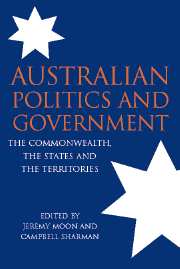Book contents
- Frontmatter
- Contents
- List of contributors
- List of figures and tables
- Acknowledgements
- 1 Introduction
- 2 The Commonwealth
- 3 New South Wales
- 4 Queensland
- 5 South Australia
- 6 Tasmania
- 7 Victoria
- 8 Western Australia
- 9 Australian Capital Territory
- 10 Northern Territory
- 11 One System or Nine?
- Note on Sources and Links to the Web
- Notes
- Appendix: Periods in Office
- References
- Index
2 - The Commonwealth
Published online by Cambridge University Press: 05 September 2012
- Frontmatter
- Contents
- List of contributors
- List of figures and tables
- Acknowledgements
- 1 Introduction
- 2 The Commonwealth
- 3 New South Wales
- 4 Queensland
- 5 South Australia
- 6 Tasmania
- 7 Victoria
- 8 Western Australia
- 9 Australian Capital Territory
- 10 Northern Territory
- 11 One System or Nine?
- Note on Sources and Links to the Web
- Notes
- Appendix: Periods in Office
- References
- Index
Summary
The Commonwealth government was born of compromise and reared on opportunism. The centenarian of 2001 is unlike the infant conceived by its progenitors in 1901. Its powers are greater, its influence more extensive. The number of departments has fluctuated. Seven departments in 1901 grew to a maximum of twenty-eight in 1985 and more recently was reduced to eighteen but with no reduction in the scope of Commonwealth government action. The programs and budgets of the federal government have become dominant in regulating the level of government activity and the direction of the economy in Australia. Federal politics is the big game, the one that is perceived as making the greatest difference. Yet the changes to the Constitution created in 1901 have been incremental and minimal; successful moves to expand the formal authority of the federal government have been few.
Changes to the provisions of the Constitution were to be determined by referendums, with support from a majority of states and a majority of voters. But such proposals for constitutional change have a record of failure. Since 1901 Australians have voted on forty-four proposals to alter the Constitution, the most recent being the proposal to make Australia a republic, a proposal that failed. Constitutional referendums have been successful on only eight occasions, demonstrating a general reluctance on the part of Australians to allow the government in Canberra any greater control. But this reluctance to accept formal constitutional change has not prevented a transfer of power from the states to the federal government.
- Type
- Chapter
- Information
- Australian Politics and GovernmentThe Commonwealth, the States and the Territories, pp. 12 - 40Publisher: Cambridge University PressPrint publication year: 2003
- 2
- Cited by



